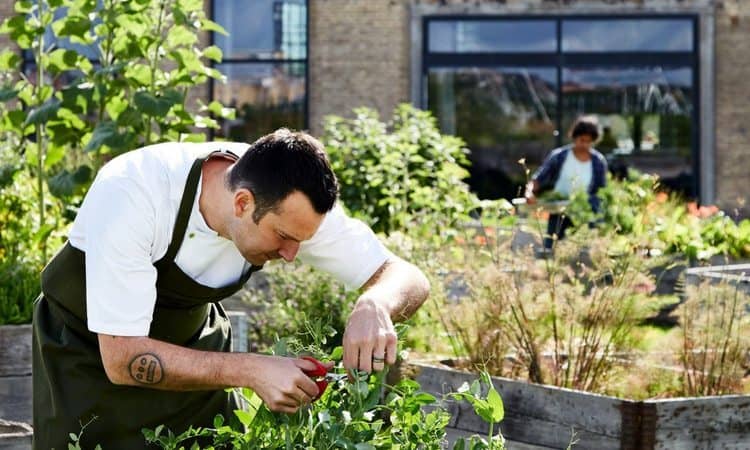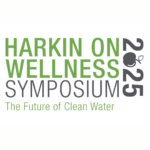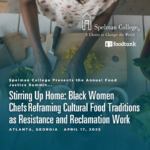This is a guest article written by Food Tank Advisory Board Member Jonathan Bloom. Bloom is the author of American Wasteland and creator of the blog “Wasted Food.” Find him on Twitter at @wastedfood.
Matthew Orlando is the owner and head chef at Amass Restaurant in Copenhagen. He was the chef de cuisine at Noma (you may have heard of it…) from 2010 to 2013, when he left to start Amass. Prior to his time at Noma, Orlando worked at the renowned restaurants Per Se in New York City and The Fat Duck in the UK. The native Californian has now lived in Copenhagen for more than six years and was kind enough to share his thoughts on the cooking, culture, and Venn diagrams.
Jonathan Bloom (JB): I’ve heard you’re pretty obsessed with avoiding waste. Where does that come from?
Matthew Orlando (MO): I think this came from working in high-end kitchens that did not take into consideration the impact of the amount of waste that was being produced. The only thing that mattered was the end product. What happened along the way was an afterthought. When I opened Amass, I vowed to never adopt this way of thinking. In fact, I vowed to approach cooking in the opposite way. There is no such thing as a by-product, only another product.
JB: How does that manifest itself in the day-to-day operation of Amass? Can you summarize a few examples of kitchen innovations aimed at using everything?
MO: At Amass, we save all of the stems from the different herbs that we use, put them through a lactic fermentation, dry them, and grind them to a powder. The powder tastes like seaweed. We then use the powder to season vegetables and different oils. We also save all of our leftover bread and soak it in the whey that is leftover from making our fresh cheese. The next day, we puree it and make a chip out of it. We save all of our leftover coffee grinds, dry them overnight, and mill them to a flour. We then make crisps out of them that we serve with a marshmallow that is made with the leftover tea leaves from the previous night’s service that we burn to an ash. We even save all of our water from our ice baths and circulator baths, as well as the water leftover from the bottles on the tables. We boil it up and use it to wash the floor in the kitchen.
JB: I’ve heard you talk about a fish called bakskuld—can you tell me how Amass’ practice compares to most Danish restaurants?
MO: Most restaurants use the bones to infuse sauces with a smoky flavor [and then throw them away]. At Amass, we look at the entire fish. We freeze the flesh, grind it up, and dry it. We then roast it in oil to make a smoked fish crumble. The skin we infuse in oil overnight. We marinate cherries and summer beans in this smoked fish oil. We infuse the bones into stocks to achieve a smoky flavor. After that, we strain the bones out of the stock and cook them overnight in the steam oven. We then roast them and serve them with different dipping sauces.
JB: Are other restaurants in Copenhagen similarly experimental with nose-to-tail and root-to-stem dining?
MO: BROR is doing an unbelievable job with nose-to-tail cooking. They are utilizing the absolute entire animal. They serve the entire lamb head in different servings: stuffed eyeballs, with the tongue and the meat of the cheeks and forehead wrapped in little pancakes.
JB: Has this “use-it-all” cooking become somewhat the norm in Denmark or is it only happening at places like Noma and Amass?
MO: It is definitely not the norm yet, especially at high-end restaurants. I think a lot of people talk about it but fail to follow through. There are just a few restaurants that are starting to realize the importance of adopting this way of thinking. For me, it is the only way that our industry will be able to cook in the future with the products we use now. Right now, we, as an industry, are cooking very irresponsibly.
JB: What comes to mind when you say we’re cooking irresponsibly? And how do we change that?
MO: As a whole, we are cooking with no thought of the impact that we are having on the environment. Everything is at our fingertips. Foods are being flown in from around the world with no thought of the carbon footprint that they leave behind. We are taking the center cut of meat or seafood and discarding the rest. How do we change? We need to look at what’s around us. We need to start cooking more locally. We need to look at the entire product, whether it’s meat, fish, or vegetables. We need to let the by-product of refinement become part of our daily repertoire.
JB: How do diners respond to these kinds of experimentations?
MO: The response has been great. When you feed someone a by-product of something else they had earlier in the menu and explain how you transformed it into something that is delicious, it is a real eye-opener. It becomes something they can touch and taste and not something they have just heard about.
JB: On the Venn diagram of New Nordic cuisine and avoided food waste, where is the overlap?
MO: I think that we have a great culture of preservation through salting and fermenting. These are both excellent ways to make items that are usually undesirable taste delicious.
JB: How would you compare the average Copenhagen restaurant customer to the ones you saw in New York at Per Se or in Britain at The Fat Duck?
MO: Diners in Copenhagen are far more open-minded. What I love most about cooking in Copenhagen is that the guests come to eat whatever the chef is cooking, versus those places where I worked previously in which the guest comes and butchers the menu by telling you what they don’t want to eat. The sense of freedom in Copenhagen is amazing. People are looking for something a bit outside the box. So if you do something that is too traditional, then people will tell you that it just wasn’t that exciting. This keeps the chefs pushing and looking for the next new ingredient or flavor combination that sets them apart.














